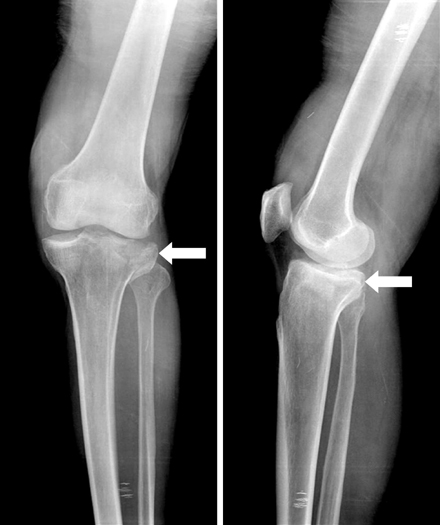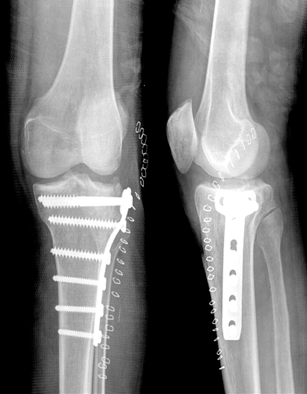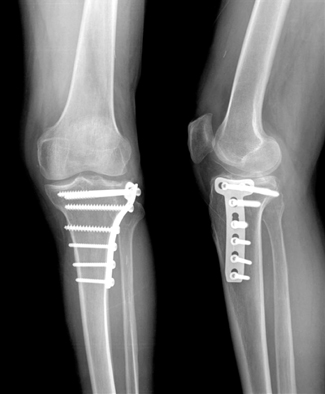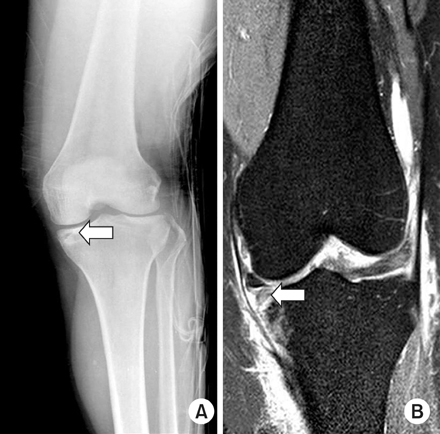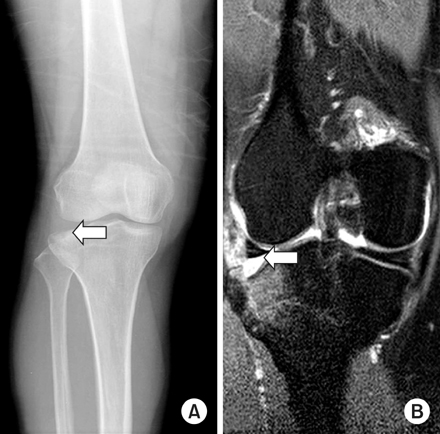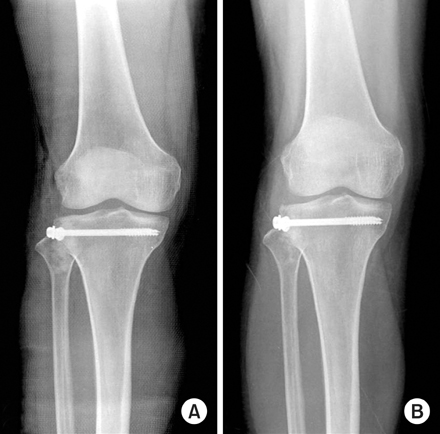J Korean Fract Soc.
2010 Jan;23(1):26-33. 10.12671/jkfs.2010.23.1.26.
The Use of Fresh Frozen Allogenic Bone Graft in the Impacted Tibial Plateau Fractures
- Affiliations
-
- 1Department of Orthopedic Surgery, Wonkwang University College of Medicine, Iksan, Korea. oschae@naver.com
- 2Department of Anesthesiology and Pain Medicine, Wonkwang University College of Medicine, Iksan, Korea.
- KMID: 1461569
- DOI: http://doi.org/10.12671/jkfs.2010.23.1.26
Abstract
- PURPOSE
To assess the behaviour of fresh frozen cancellous allograft used for supporting the reconstructed articular surface in impacted tibial plateau fractures.
MATERIALS AND METHODS
Between May 2004 and May 2008, 13 cases of impacted tibial plateau fracture were evaluated retrospectively. All fractures were treated with open reduction-internal fixation after restoration of the tibial plateau surface and insertion of fresh frozen cancellous allograft chips for subchondral support. Mean age was 46.6 (31~65) years. Average follow-up period was 36 (13~58) months. The radiological and clinical result for every patient was assessed according to the modified Rasmussen's system and Lysholm's knee score.
RESULTS
According to last follow-up weight bearing A-P X-ray, the fresh frozen cancellous allograft incorporated soundly in all cases and no complications such as joint depression, fracture reduction loss, angular deformity, and malunion were found. The mean time to complete bone union was postoperative 10+/-0.7 weeks. The mean range of motion was 135 (115~145) degrees. The mean Rasmussen's radiological score at last follow up was 15.3 (10 cases: excellent, 3 cases: good). The mean Lysholm's knee score at last follow up was 88.2+/-4.3.
CONCLUSION
We concluded that fresh frozen cancellous allograft in impacted tibial plateau fractures showed good results in terms of bone union and functional improvement and was considered to be a good structural supporter.
Keyword
MeSH Terms
Figure
Cited by 1 articles
-
Treatment of Tibial Plateau Fractures Using a Locking Plate and Minimally Invasive Percutaneous Osteosynthesis Technique
Hee-Gon Park, Dae-Hee Lee, Kyung Joon Lee
J Korean Fract Soc. 2012;25(2):110-116. doi: 10.12671/jkfs.2012.25.2.110.
Reference
-
1. Bennett WF, Browner B. Tibial plateau fractures: a study of associated soft tissue injuries. J Orthop Trauma. 1994. 8:183–188.2. Chun JY, Park HG, Hwang SS. Evaluation of the patterns of fractures and the soft tissue injury using MRI in tibial plateau fractures. J Korean Fract Soc. 2007. 20:302–308.
Article3. Finkemeier CG. Bone-grafting and Bone-graft substitues. J Bone Joint Surg Am. 2002. 84:454–464.4. Holt MD, Williama LA, Dent CM. MRI in the management of tibial plateau fractures. Injury. 1995. 26:595–599.
Article5. Honkonen SE. Degenerative arthritis after tibial plateau fractures. J Orthop Trauma. 1995. 9:273–277.
Article6. Hsu CJ, Chang WN, Wong CY. Surgical treatment of tibial plateau fracture in elderly patients. Arch Orthop Trauma Surg. 2001. 121:67–70.
Article7. Jubel A, Andermahr J, Mairhofer J, Prokop A, Harn U, Rehm KE. Use of the injectable bone cement Norian SRS for tibial plateau fractures. Results of a prospective 30-month follow-up study. Orthopade. 2004. 33:919–927.8. Kim JW, Oh CW, Oh JK, et al. Staged minimally invasive plate osteosynthesis of proximal tibial fracure. J Korean Fract Soc. 2009. 22:6–12.
Article9. Lasanianos N, Mouzopoulos G, Garnavos C. The use of freeze-dried cancellous allograft in the management of impacted tibial plateau fractures. Injury. 2008. 39:1106–1112.
Article10. Lobenhoffer P, Gerich T, Witte F, Tscherne H. Use of an injectable calcium phosphate bone cement in the treatment of tibial plateau fractures: a prospective study of twenty-six cases with twenty-month mean follow-up. J Orthop Trauma. 2002. 16:143–149.
Article11. Lohmann H, Grass G, Rangger C, Mathiak G. Economic impact of cancellous bone grafting in trauma surgery. Arch Orthop Trauma Surg. 2007. 127:345–348.
Article12. Lysholm J, Gillquist J. Evaluation of knee ligament surgery results with special emphasis on use of a scoring scale. Am J Sports Med. 1982. 10:150–154.
Article13. Mueller CA, Eingartner C, Schreitmueller E, et al. Primary stability of various forms of osteosynthesis in the treatment of fratures of the proximal tibia. J Bone Joint Surg Br. 2005. 87:426–432.14. Newman JT, Smith WR, Ziran BH, Hasenboehler EA, Stahel PF, Morgan SJ. Efficacy of composite allograft and demineralized bone matrix graft in treating tibial plateau fractures with bone loss. Orthopedics. 2008. 31:649.
Article15. Russell TA, Leighton RK. Comparison of autogenous bone graft and endothermic calcium phosphate cement for defect augmentation in tibial plateau fractures. A multicenter, prospective, randomized study. J Bone Joint Surg Am. 2008. 90:2057–2061.
Article16. Schatzker J, McBroom R, Bruce D. The tibial plateau fracture. Clin Orthop Relat Res. 1979. 138:94–104.17. Segur JM, Torner P, García S, Combalía A, Suso S, Ramón R. Use of bone allograft in tibial plateau fractures. Arch Orthop Trauma Surg. 1998. 117:357–359.
Article
- Full Text Links
- Actions
-
Cited
- CITED
-
- Close
- Share
- Similar articles
-
- Fractors Influencing the Results of Operative Treatment of Tibial Plateau Fractures
- Arthroscopic and Conventional Treatment of Lateral Tibial Plateau Fractures
- Arthroscopically-Assisted Reduction and Internal Fixation of Intra-Articular Fractures of the Lateral Tibial Plateau
- Evaluation of the Patterns of Fractures and the Soft Tissue Injury Using MRI in Tibial Plateau Fractures
- Arthroscopic Assisted Intra-Articular Reduction and Internal Fixation of Tibia Plateau Fracture

